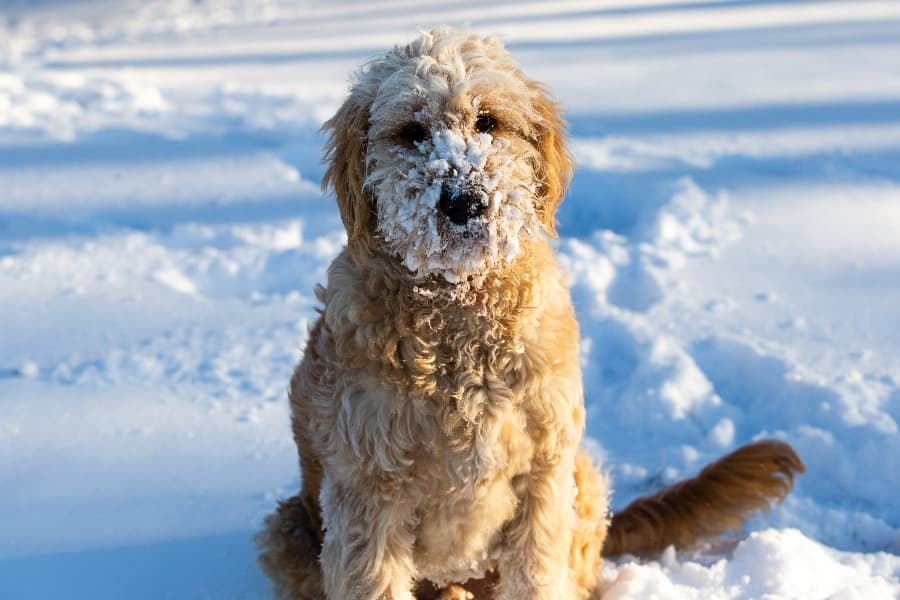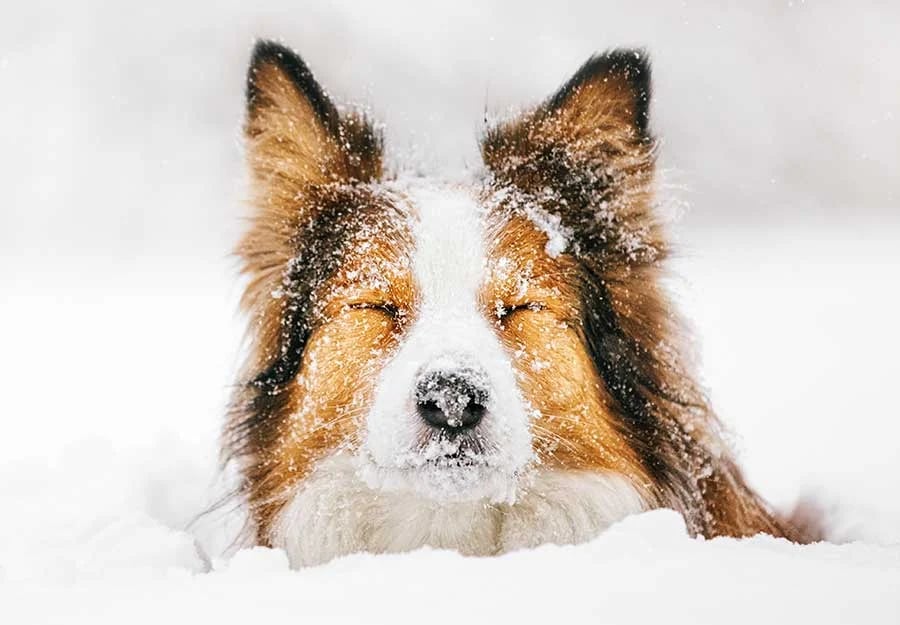
When winter arrives, the world turns into a magical wonderland of pristine whiteness. While your furry friend may not seem to mind, it's important to know how cold is too cold for a dog when the mercury drops.
Your dog likes to be wherever you are - even outdoors in the snow and cold weather. The animal thrives on fresh air and exercise.
Not all dogs respond to cold climates the same. There are cold averse dogs such as small breed dogs or very young dogs who simply cannot tolerate cold weather.
Some breeds are made to withstand extreme temperatures, such as the Siberian Husky, Malamute, Samoyed, and other large breed dogs.
Short-haired, toy breeds, seniors and sick dogs might be in danger outdoors in cold temperatures. They could develop cold-associated health problems in colder temperatures.
When Is It Too Cold for Dogs?
It's important for pet owners to follow cold temperature guidelines to keep their dogs warm during winter walks in the cold winter months.
You want to always ensure your pet's well-being when the temperatures drop by reducing the likelihood of health risks.
-
-
Moderate Cold (0 to -10°C / 32-14°F): Dogs may need extra protection; with appropriate gear, they can continue regular outdoor activities.
-
Extreme Cold (Below -10°C / 14°F): Higher risk for dogs, especially in regions like the Canadian prairies or northern Canada, where temperatures can plummet.
-
Dangerous Cold (Around -40°C/F): Even winter-loving dogs struggle; prolonged exposure is not advisable.
-
Consider Air Temperature: If you're uncomfortable outside, your dog likely is too; limit outdoor time in cold, windy conditions.
-
Pet parents must remember that air temperature and wind chill are all factors to consider. If you feel uncomfortable outdoors, your canine buddy might too. Limit time outdoors if there is a brisk breeze.
Larger dogs with ample hair can spend longer outdoors than shorthaired, aging, young or small breeds.
Senior dogs, young pups, small breeds, canines with health problems and those with thin coats are at increased risk of developing dog hypothermia if their body temperature drops in extreme cold temperatures or if they have wet fur.

Hypothermia in Dogs
Dog owners will want to keep a close eye on their pets and watch for symptoms of dog hypothermia in dogs.
Severe hypothermia in dogs can occur if you leave your pet unattended outdoors in freezing temperatures or even during an extended walk.
Young, senior, and sick dogs are at greater risk of hypothermia than healthy dogs because they lose heat faster.
In cold weather, temperature is not the only environmental factor to weigh. A dog can also develop frostbite on one or more paws if the feet are exposed to snowy and colder weather.
Cold-tolerant breeds and overweight dogs can withstand the winter weather better than smaller dogs but even they can develop snowballs and ice chunks between the paw pads during snowy weather conditions.
Symptoms of Dog Hypothermia
One dog might suffer hypothermia quicker than another such as a canine with health conditions or one who is already on veterinary medicine.
Most dogs exhibit the following symptoms:
-
- Shivering
- Breathing difficulty
- Rapid breathing
- Pale skin
- Acting anxious
- Blood vessels are difficult to see on the dog's ears
- Lethargic/sleepy
- Dilated pupils
- Skin feels chilled to the touch
- Dog's core temperature drops dip below 95 F.
- Pale gums appear blue
- Difficulty walking
- Weakness
- Quiet heartbeat
- Stupor
- Loss of consciousness/coma
Treating Hypothermia in Dogs
Suppose you're wondering how to treat a dog with mild hypothermia. In that case, you'll need to be aware that the situation can quickly become life-threatening, so you'll want to seek immediate veterinary hospital care.
Use a rectal thermometer to determine if there has been a significant drop in core temperature that can impact essential organs. Low temperatures can indicate hypothermia.
If your dog shows signs of hypothermia, seek medical care. With rapid treatment, many dogs (even older dogs) recover without suffering from kidney disease or some other long-term problem.
-
- Remove from Cold: Quickly bring dogs to warm locations.
- Dry Fur: Use a hair dryer for drying wet fur.
- Warm Environment: Place your dog in a warm area.
- Insulation: Dress your dog in thick coats for warmth.
- Stimulate Circulation: Gently rub the pet's extremities.
- Apply Heat: Use a hot water bottle or heating pad (with caution) to raise their core temperature.
- Warm Hydration: Offer warm water to drink.
- Heated Bedding: Wrap your dog in blankets warmed in a clothes dryer.
- Temperature Check: Ensure your dog's temperature is above 95°F (35°C).
- Feeding Warm Pet Food: Warm the internal organs with heated pet food to slowly raise the low core temperature and also increase low blood sugar. Always factor in the dog's size when considering the to-volume ratio.
Tips to Keep Your Dog Warm in Cold Temperatures

Even if the temperature on the thermometer reads that it's not that chilly does not mean that it's comfortable for your dog. Dogs feel cold differently and many will show body temperatures that fluctuate.
Wind Chill
Even a light wind has the ability to cut through a canine's fur like a knife slicing through butter. When the wind is intense, the insulating ability of a dog's coat plummets. This is especially true for dogs with exceptionally thin coats. The Arctic breed's double-layered coats tend to provide enough extra body heat so the pup stays warm even in cold weather.
Overcast Days
You might notice that on cloudy days the temperature feels colder. . Cloud cover impedes the ability of the dog to absorb the warming rays.
Dampness/Excessive Moisture
Snow, freezing rain, sleet, fog, and more create dampness that can quickly sink into your dog's bones and make the pooch feel miserable. Even if the outdoor temperature is not that chilly, the moisture in the air that settles into the dog's fur starts to cause the animal's core temperature to spiral down.
Remain Active
When an animal is active, they start to generate body heat and show greater cold tolerance which helps to maintain normal temperatures even in harsh northern climates.
Embrace the Sun
Dark-coated dogs absorb the heat from the sun better. Black and other dark-coated dogs can stay warmer during a temperature drop if the sun is out because they absorb significant amounts of heat. However, even dark-coated small dogs other other vulnerable dogs will often need a sweater to keep the core warm
Frequently Asked Question
What is canine hypothermia?
Hypothermia in dogs occurs when their body temperature falls well below the normal range of 100.5 to 102.5°F (38 to 39.2°C).
What are the symptoms of mild hypothermia in dogs?
Signs of hypothermia in dogs include shivering, lethargy, weakness, pale gums, dilated pupils, chilled skin to the touch, slowed heart rate, shallow breathing, and in severe cases, loss of consciousness.
How can I prevent hypothermia in dogs?
To prevent canine hypothermia, provide your pooch with proper insulation, such as a warm coat or sweater.
What should I do if I suspect my dog has mild hypothermia?
Move your pup to a warm area, wrap them in blankets, and use gentle warming methods like heating pads to gradually bring up the dog's temperature. Avoid direct heat, and contact a vet since severe hypothermia can be life-threatening.
Can certain dog breeds be more prone to hypothermia?
Dog breeds more susceptible to hypothermia include smaller, short-haired dogs, those with little body fat, and breeds native to warmer climates.
When is it appropriate to seek veterinary care for a dog with moderate hypothermia?
If your pup's temperature drops dangerously low or their condition doesn't improve after attempting to warm them up, it's essential to seek immediate veterinary care.
.png?width=200&height=66&name=logo%20(1).png)



